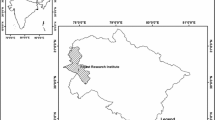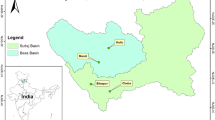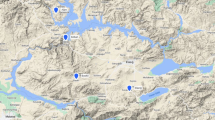Abstract
Potential evapotranspiration (ETo) is an essential hydrologic parameter for having better understanding for hydrologic cycle in certain catchment area. In addition, ETo is vital for calculating the agricultural demand. In fact, Penman-Monteith (PM) method is considered as reference method for estimating (ETo), however, this method required a lot of data to be used which is not usually available in many catchment areas. Furthermore, there are several efforts that have been performed as competitor to reach accurate estimation of (ETo) when there is lack of data to utilize (PM) method, but still required numerous research. Recently, methods based on Artificial Intelligence (AI) have been suggested to provide reliable prediction model for several application in engineering and especially for hydrological process. However, time series prediction based on Artificial Neural Network (ANN) learning algorithms is fundamentally difficult and faces problem. One of the major shortcomings is that the ANN model experiences over-fitting problem during training session and also occurs when a neural network loses its generalization. In this research a modification for the classical Multi Layer Preceptron- Artificial Neural Network (MLP-ANN) modeling namely; Ensemble Neural Network (ENN) is proposed and applied for predicting daily ETo. The proposed model applied at two different region with two different climatic conditions, Rasht city located north part of Iran and Johor Bahru City, Johor, Malaysia using maximum and minimum daily temperature collected from 1975 to 2005. The result showed that the ENN outperformed the classical MLP-ANN method and successfully predict daily ETo utilizing maximum and minimum temperature only with satisfactory level of accuracy. In addition, the proposed model could achieve accuracy level better than the traditional competitor methods for ETo.








Similar content being viewed by others
References
Allen RG, Pruitt WO (1991) FAO-24 reference evapotranspiration factors. J Irrig Drain Eng 117(5):758–773
Awchi TA (2008) Application of radial basis function neural networks for reference evapotranspiration prediction. Al-Rafidain Eng 16(1):117–129
Bishop CM (1996) Neural networks for pattern recognition, 1st edn. Oxford University Press, Oxford
Blaney HF, Criddle WD (1962) Determining consumptive use and irrigation water requirements. US Dept Agric Agric Res Serv Tech Bull 1275, 59p
Brutsaert WH (1982) Evaporation into the atmosphere. D. Reidel, Dordrecht
Chandra A, Yao X (2006) Evolving hybrid ensembles of learning machines for better generalization. Neurocomputing 69:686–700
Chauhan S, Shrivastava RK (2008) Performance evaluation of reference evapotranspiration estimation using climate based methods and artificial neural networks. Water Resour Manag 23:825–837
El-Shafie A, Taha MR, Noureldin A (2007) A neuro-fuzzy model for inflow forecasting of the Nile river at Aswan high dam. Water Resour Manag 21(3):533–556
El-Shafie A, Abdin AE, Noureldin A, Taha MR (2009) Enhancing inflow forecasting model at Aswan high dam utilizing radial basis neural network and upstream monitoring stations measurements. Water Resour Manag 23(11):2289–2315
Hargreaves GH, Samani ZA (1985) Reference crop evapotranspiration from temperature. Appl Eng Agric 1(2):96–99
Hsu K, Gupta HV, Sorooshian S (1995) Artificial neural network modeling of the rainfall-runoff process. Water Resour Res 31(10):2517–2530
Imrie CE, Durucan S, Korre A (2000) River flow prediction using artificial neural networks: Generalization beyond the calibration range. J Hydrol 233:138–153
Jain SK, Das A, Srivastava DK (1999) Application of ANN for reservoir inflow prediction and operation. J Water Resour Plan Manag 125(5):263–271
Khoob AR (2008) Comparative study of Hargreaves’s and artificial neural network’s methodologies in estimating reference evapotranspiration in a semiarid environment. Irrig Sci 26(3):253–259
Kumar M, Raghuwanshi NS, Singh R, Wallender WW, Pruitt WO (2002) Estimating evapotranspiration using artificial neural network. J Irrig Drain Eng 128(4):224–233
Maier HR, Dandy GC (1999) Empirical comparison of various methods for training feed-forward neural networks for salinity forecasting. Water Resour Res 35(8):2591–2596
Sudheer KP, Gosain AK, Ramasastri KS (2003) Estimating actual evapotranspiration from limited climatic data using neural computing technique. J Irrig Drain Eng 129(3):214–218
Sulaiman M, El-Shafie A, Karim O, Basri H (2011) Improved water level forecasting performance by using optimal steepness coefficients in an artificial neural network. Water Resour Manag 25(10):2525–2541
Tokar AS, Johnson PA (1999) Rainfall-runoff modeling using artificial neural networks. J Hydrologic Eng 4(3):232–239
Trajkovic S, Todorovic B, Stankovic M (2003) Forecasting of reference evapotranspiration by artificial neural networks. J Irrig Drain Eng 129(6):454–457
Wang YM, Traore S, Kerh T (2008) Neural network approach for estimating reference evapotranspiration from limited climatic data in Burkina Faso. WSEAS Trans Comput 7(6):704–713
Zanetti SS, Sousa EF, Oliveira VPS, Almeida FT, Bernardo S (2007) Estimating evapotranspiration using artificial neural network and minimum climatological data. J Irrig Drain Eng 133(2):83–89
Author information
Authors and Affiliations
Corresponding author
Rights and permissions
About this article
Cite this article
El-Shafie, A., Najah, A., Alsulami, H.M. et al. Optimized Neural Network Prediction Model for Potential Evapotranspiration Utilizing Ensemble Procedure. Water Resour Manage 28, 947–967 (2014). https://doi.org/10.1007/s11269-014-0526-1
Received:
Accepted:
Published:
Issue Date:
DOI: https://doi.org/10.1007/s11269-014-0526-1




